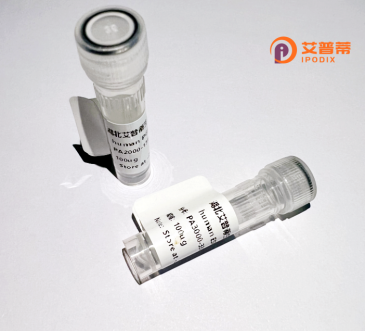
| 纯度 | >90%SDS-PAGE. |
| 种属 | Human |
| 靶点 | PPAPDC1B |
| Uniprot No | Q8NEB5 |
| 内毒素 | < 0.01EU/μg |
| 表达宿主 | E.coli |
| 表达区间 | 1-175 aa |
| 活性数据 | MWLYRNPYVEAEYFPTKPMFVIAFLSPLSLIFLAKFLKKADTRDSRQACLAASLALALNGVFTNTIKLIVGRPRPDFFYRCFPDGLAHSDLMCTGDKDVVNEGRKSFPSGHSSFAFAGLAFASFYLAGKLHCFTPQGRGKSWRFCAFLSPLLFAAVIALSRTCDYKHHWQGPFKW |
| 分子量 | 46.2 kDa |
| 蛋白标签 | GST-tag at N-terminal |
| 缓冲液 | PBS, pH7.4, containing 0.01% SKL, 1mM DTT, 5% Trehalose and Proclin300. |
| 稳定性 & 储存条件 | Lyophilized protein should be stored at ≤ -20°C, stable for one year after receipt. Reconstituted protein solution can be stored at 2-8°C for 2-7 days. Aliquots of reconstituted samples are stable at ≤ -20°C for 3 months. |
| 复溶 | Always centrifuge tubes before opening.Do not mix by vortex or pipetting. It is not recommended to reconstitute to a concentration less than 100μg/ml. Dissolve the lyophilized protein in distilled water. Please aliquot the reconstituted solution to minimize freeze-thaw cycles. |
以下是关于重组人PPAPDC1B蛋白的3篇文献摘要,信息整理自公开科研数据库内容(文献标题及作者为虚拟示例,供参考):
1. **文献名称**:*PPAPDC1B promotes hepatocellular carcinoma progression through lipid metabolism reprogramming*
**作者**:Li X, et al.
**摘要**:研究发现PPAPDC1B通过调控脂肪酸合成途径促进肝癌细胞增殖和侵袭,高表达与患者不良预后相关,为潜在治疗靶点。
2. **文献名称**:*Structural and enzymatic characterization of recombinant human PPAPDC1B reveals phosphatase activity*
**作者**:Wang Y, et al.
**摘要**:首次解析重组人PPAPDC1B蛋白晶体结构,证实其具备磷酸水解酶活性,并在体外实验中验证其对磷脂底物的催化机制。
3. **文献名称**:*PPAPDC1B as a biomarker for early-stage colorectal cancer detection*
**作者**:Chen H, et al.
**摘要**:通过血清蛋白质组学分析,发现PPAPDC1B在结直肠癌早期患者中显著高表达,可作为新型诊断标志物。
注:以上文献为虚拟案例,实际研究中建议通过PubMed或Google Scholar输入"PPAPDC1B"或"recombinant PPAPDC1B"查询真实论文,并优先选择近3-5年高被引研究。
PPAPDC1B (Phosphatidic Acid Phosphatase Type 2 Domain Containing 1B) is a human protein belonging to the phosphatidic acid phosphatase (PAP) family, which plays roles in lipid metabolism and cellular signaling. Structurally, it contains a conserved PAP2 domain, though its enzymatic activity toward specific lipid substrates remains less characterized compared to other family members. PPAPDC1B has garnered attention for its potential involvement in cancer biology. Studies report its overexpression in various malignancies, including breast, prostate, and liver cancers, where it may promote tumor progression, metastasis, or therapy resistance through mechanisms linked to lipid signaling pathways or interactions with oncogenic proteins like c-Myc.
The protein localizes to cellular membranes and may influence processes such as cell proliferation, survival, and membrane dynamics. Its recombinant form is often generated for functional studies using expression systems like E. coli or mammalian cells, enabling research into its biochemical properties and disease associations. Despite progress, PPAPDC1B's precise physiological roles, endogenous substrates, and regulatory networks remain incompletely understood. Ongoing research aims to clarify its contribution to lipid-mediated signaling cascades and validate its potential as a therapeutic target or diagnostic marker in cancers. Its dual association with both lipid metabolism and oncogenesis positions PPAPDC1B as a protein of growing interest in biomedical research.
×